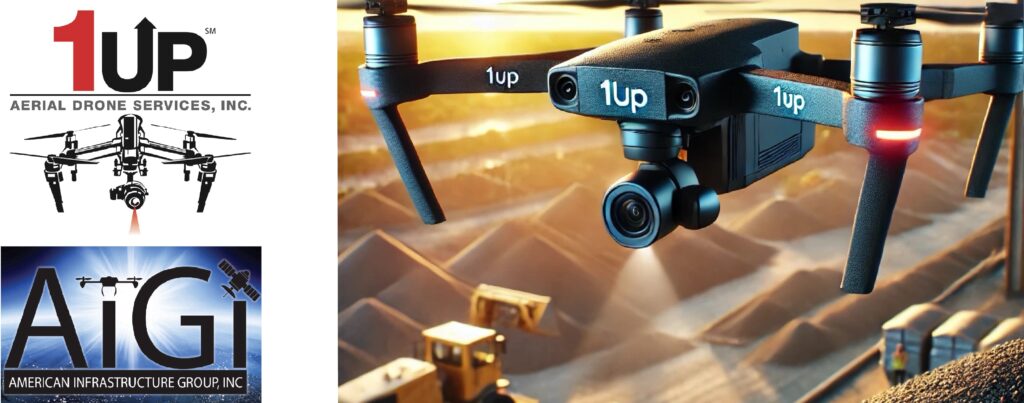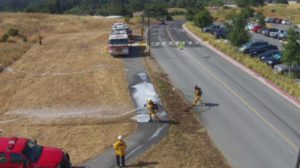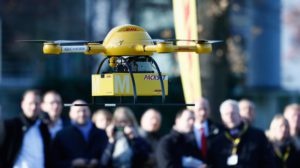
Cutting-Edge Drone Services:
A Guide to Maximizing Efficiency and Accuracy of Construction Projects
Written By Richard Armstrong – Software Engineer & Drone Expert – September 2024
In today’s ultra-modern fast-paced construction industry, leveraging advanced technology is no longer a luxury—it’s a necessity. Drones have emerged as a game-changing tool, offering unprecedented capabilities that are transforming how construction projects are planned, monitored, and executed. Whether you’re a project manager, a site supervisor, or an executive decision-maker, understanding the full potential of drone services is crucial for staying ahead in the competitive construction landscape. This article delves into seven critical drone services that can provide immediate value to your projects, ensuring you achieve greater efficiency, accuracy, and return on investment (ROI).
1. Site Mapping and Modeling
Why It Matters: Traditional site mapping methods, while reliable, are often time-consuming and subject to human error. Drones offer a modern solution, delivering high-resolution “digital twin” 3D maps and models in a fraction of the time. These maps can be used for everything from initial site planning to ongoing project monitoring.
How It Works: Equipped with LiDAR or photogrammetry payloads, drones capture aerial imagery that is processed to create detailed topographical maps and 3D models. These deliverables are crucial for site analysis, volume calculations, and ensuring that the site grading is correct before construction begins. Moreover, these models can be integrated with Building Information Modeling (BIM) software, allowing for seamless collaboration between teams and stakeholders.
Impact: By providing accurate and up-to-date site information, drone mapping and modeling services minimize costly errors and rework, ensuring that projects stay on schedule and within budget. The ability to visualize the site from multiple angles also aids in decision-making, particularly during the early planning stages.
Use Cases:
In a major U.S. infrastructure project, traditional methods of site surveying were unable to keep pace with the dynamic changes happening on-site, leading to significant delays and cost overruns. By integrating drone-based site mapping and real-time 3D modeling, the project team could generate accurate and timely visual data, which reduced rework by 30% and saved 20% of the overall time during the site preparation phase. This reduction in rework and improved time management highlights how drones significantly enhance the accuracy and speed of site assessments compared to traditional surveying methods.
Drones equipped with high-resolution cameras and LiDAR scanners allowed for continuous monitoring and real-time data processing, significantly improving decision-making and project coordination. This not only reduced delays and costs but also minimized safety risks on-site by removing the need for manual inspections in hazardous areas. These advancements allowed for more frequent updates and faster decision-making, ultimately improving project outcomes and preventing further delays and cost overruns.
Chuck Adams, founder of 1UP Drones, explains:
“Wilmore & Co. has contracted a handful of projects with 1UP because of the safety, security, affordability, and productivity seen on each project. A LiDAR project that we were contracted by the Applegate Group with Kris Crawford from Wilmore & Co. as our partner saved an estimated $22,000 in survey costs and over two months in costly delays. Not to mention the enhanced safety due to the extreme terrain that the drone can model where it would be hard for survey crews to trek. Craig Ullman, Vice President of the Applegate Group, stated, ‘The raw amount of data that the drone with LiDAR sensors collected led to more precision, which equals fewer surprises and more accurate canal rehabilitation estimates from the Applegate Group construction subcontractors.’”
2. Progress Monitoring and Reporting
Why It Matters: Keeping a construction project on track requires constant monitoring and reporting. Traditional methods often involve manual inspections, which can be time-intensive and may not always capture the full picture. Drones revolutionize this process by offering real-time data collection and analysis.
How It Works: Regular drone flights over the construction site capture high-resolution images and videos, which are then processed into orthomosaic maps and 3D models. These can be overlaid with previous data to track progress, identify deviations from the plan, and highlight areas that require attention.
Impact: Progress monitoring via drones allows for more accurate reporting to stakeholders, facilitating transparency and trust. It also enables project managers to make informed decisions quickly, reducing the likelihood of project delays and cost overruns. This service is particularly valuable for large-scale projects, where traditional monitoring methods may fall short.
Use Cases:
In the UK, a large-scale residential development project faced challenges in maintaining progress visibility across its sprawling site. Manual inspections were proving inefficient and often led to inconsistent data collection. By adopting drone technology for progress monitoring, the project achieved significant improvements: a 40% increase in on-time delivery and a 25% reduction in inspection costs. These gains were driven by the drones’ ability to collect precise, real-time data more frequently and consistently, enhancing both decision-making and overall project efficiency.
This use case aligns with broader trends in the UK construction sector, where drones are increasingly being used to optimize time and cost management, with some estimates suggesting potential savings of billions by 2030 due to widespread drone adoption
Chuck Adams, founder of 1UP Drones, adds:
“At 1UP, we provided Becknell Industrial’s Denver office with real-time updates and communication to key stakeholders in their corporate headquarters in La Grange, Illinois, as well as to key decision-makers at Amazon in Seattle, WA. Monthly external progress reports turned into weekly internal and external site monitoring progress reports for the highly automated Amazon Distribution Center in Commerce City, CO, due to the value of the data and information provided. Thousands of dollars in travel, time, and productivity savings were realized with the use of 1UP Aerial Drone Services throughout the 24-month construction project. Becknell Industrial saw the value in the weekly flights and expanded our contracted operations to a nearby 2-million-square-foot Lowe’s distribution center and two smaller Becknell Industrial ‘spec’ buildings.”
You can check out a video of the work here:
3. Inspection and Safety Audits
Why It Matters: Ensuring safety and structural integrity is paramount on any construction site. Drones provide an efficient and safe way to perform inspections, especially in hazardous or hard-to-reach areas.
How It Works: Drones equipped with high-definition cameras and thermal imaging sensors can conduct thorough inspections of construction sites, scaffolding, and infrastructure elements. They can identify potential safety hazards, such as loose scaffolding or structural weaknesses, without putting personnel at risk.
Impact: Regular drone inspections lead to safer construction sites by identifying and mitigating risks before they become critical issues. This not only protects workers but also ensures compliance with safety regulations, thereby avoiding costly penalties and project delays. Additionally, the high-resolution imagery captured by drones allows for more detailed and accurate inspections compared to traditional methods.
Use Case:
A construction company in Canada used drone technology to inspect high-rise scaffolding, which had traditionally been a time-consuming and risky task. By employing drones, the company was able to complete the inspection in half the time compared to manual methods. This reduced the need for workers to be in dangerous positions, allowing for safer operations. Moreover, the drones identified safety issues that were previously missed during manual inspections, leading to a 50% reduction in safety incidents on-site.
Drones equipped with high-definition cameras and thermal sensors provided detailed data that enhanced the accuracy and scope of these inspections, reducing the time spent on scaffolding and improving overall site safety. This approach has proven beneficial in improving both operational efficiency and worker safety.
Chuck Adams, founder of 1UP Drones, shares:
“In 2019, Montview Boulevard Presbyterian Church required extensive roof repairs on both the existing heavy tile roof over the sanctuary and the flat roofs of the Education Wing. Our 1UP drones allowed for precise ‘areas of interest’ to be inspected and located, rather than needing to replace the entire costly roof. The project budget only allowed for the replacement of 5% of the tiles on the heavy-tiled roof and localized repairs of the underlay beneath the tile that provides waterproofing. A recommendation was also made to clean and seal the roof to prevent mold buildup and surface deterioration of the tiles. This saved the church over $1 million in repair costs for this historic building, not to mention the productivity savings from avoiding several days of scaffolding that roofers would have needed to visually inspect the tiles on a very steep roof.”
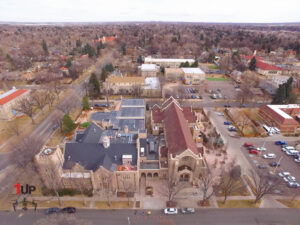

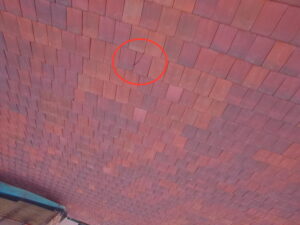
4. Material Volume Measurement
Why It Matters: Accurate material volume measurement is crucial for cost control and inventory management on construction sites. Sometimes referred to as cut-and-fill or pile volume measurement. Miscalculations can lead to delays, increased costs, and resource shortages.
How It Works: Drones can quickly and accurately measure the volume of stockpiled materials such as gravel, sand, and aggregate. By capturing aerial data and processing it with advanced software, drones generate precise volume calculations, which are essential for managing supply chains and project budgets.
Impact: Using drones for material volume measurement eliminates the guesswork from inventory management. It ensures that project managers have accurate data on hand, enabling them to make better decisions regarding material orders and allocations. This service not only improves efficiency but also contributes to better financial planning and resource management.
Use Cases:
A construction site in Australia faced significant discrepancies in material volumes between deliveries and what was being reported on-site. By implementing drone technology for material volume measurement, the company was able to reconcile these differences. The use of drones resulted in a 15% reduction in material costs, as the technology provided precise data for forecasting and helped avoid over-ordering or shortages of materials. This improvement also enhanced the accuracy of site inventory management, leading to better forecasting and decision-making for future needs.
Chuck Adams, founder of 1UP Drones, describes a similar success story:
“Mike Leidich, former CEO of Summit Brick in Pueblo, CO, serves as a prime example of effective material and volume calculation reaped from 1UP Aerial Drone Services. Upon his retirement in July 2018, Mike had a significant bonus contingent on an accurate inventory analysis of the materials left behind at Summit Brick. To ensure precision, we utilized drones to conduct the volume calculations, providing a comprehensive and accurate assessment of the inventory. In a matter of hours, 1UP created an elevation map to assess the topography of a quarry in which he had traditionally used fixed wing aircraft for material analysis. This innovative approach not only secured Mike’s well-earned bonus but also demonstrated the practical application of drone technology in material management. Summit Brick had over 42 stockpiles that were historically measured with estimates using basic volume calculations. With 1UP’s advanced drone solution, they now have more accurate assessments of the materials on hand at any given time.”
“Site evaluations [with a fixed wing aircraft] could cost us five or ten thousand dollars and take 60 days to schedule. We would much rather spend two thousand on 1UP, and schedule it for next week to collect all the data we need.”
– Michael Leidich, President, Summit Brick
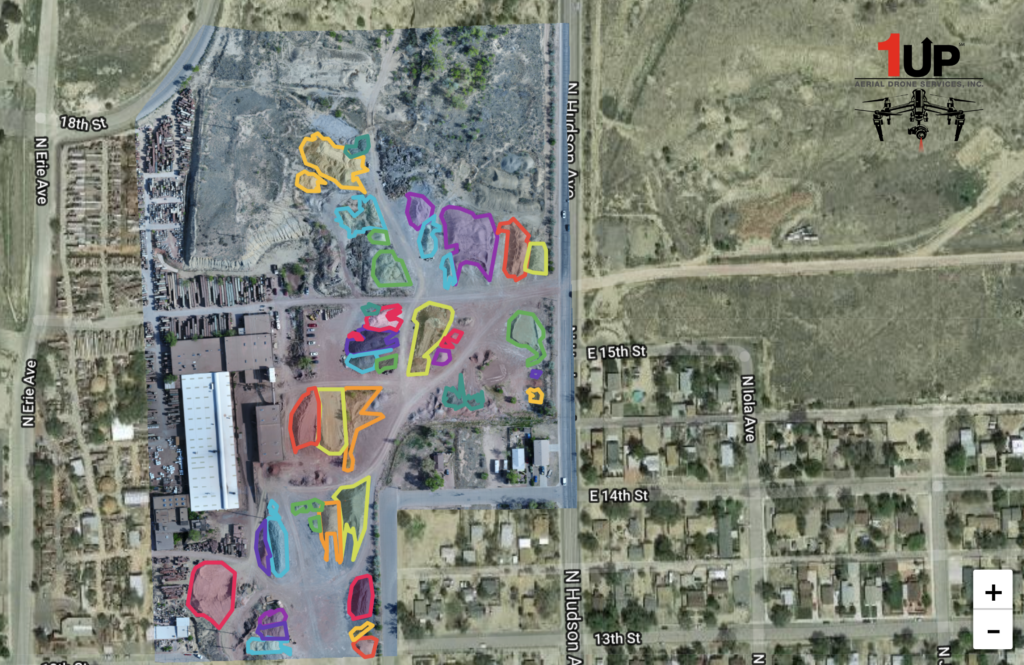
5. Marketing and Documentation
Why It Matters: High-quality visuals are essential for marketing, client updates, and project documentation. Drones offer an unparalleled perspective, providing stunning aerial imagery and videos that showcase the progress and scale of construction projects.
How It Works: Drones capture high-resolution images and videos from various angles, offering a unique view of the construction site. These visuals can be used for marketing campaigns, client presentations, or as part of the project’s historical documentation.
Impact: Incorporating drone-captured visuals into your marketing strategy can significantly enhance your company’s image and attract new clients. It also provides stakeholders with clear, compelling updates on project progress, fostering transparency and confidence. For construction companies looking to document their projects comprehensively, drones offer an efficient and cost-effective solution.
Use Cases:
A U.S.-based construction firm successfully leveraged drone footage to create a promotional video showcasing the scale and innovation of a completed project. This video not only helped the firm secure a high-profile client for their next venture but also boosted their website traffic by 30% after it went viral on social media. By utilizing high-quality aerial imagery, the firm was able to present a unique perspective of their work, which resonated with both clients and stakeholders. This case highlights the power of drone technology in marketing and documentation, providing construction companies with dynamic tools for client engagement and business growth.
Chuck Adams, founder of 1UP Drones, explains how drones are used for marketing and documentation:
“Have you watched a TV show or movie lately that hasn’t had a drone ‘establishing’ shot? Neither have we! Our construction company and real estate developer clients rely on our drone services for comprehensive progress tracking and end-of-project deliverables. But that’s not all. Using drones, we provide monthly and weekly progress reports that give real-time insights into project developments. At the conclusion of each contracted project, clients typically request 1UP Aerial Drone Services to produce a high-quality video for employee ‘all-hands’ meetings, social media, and ongoing marketing efforts. Our clients, including Victory Unlimited Construction, Becknell Industrial, Environmental Chemical Corporation, Ivy Street Design, Amberwood Cabins, and many more, have consistently benefited from this dynamic approach to project documentation and promotion.”
Chuck continues:
“Some stats from the largest concrete pour in the history of Indiana, captured by 1UP Aerial Drone Services in April 2024:
-
- 230 construction workers
- 121,348 square feet of concrete
- 9,200 cubic yards of concrete
- 130 trucks, each making 9 deliveries
- 4 pumps and 3 conveyors used simultaneously.”
You can check out a video of the work here:
6. Site Security Monitoring
Why It Matters: Construction sites are often targets for theft, vandalism, and unauthorized access, leading to significant financial losses and project delays. Drones provide a proactive approach to site security, offering real-time monitoring and deterrence.
How It Works: Drones equipped with high-definition cameras and thermal sensors can patrol construction sites after hours, identifying potential security breaches or suspicious activities. They can cover large areas quickly, providing live feeds to security personnel or triggering alerts when anomalies are detected.
Impact: Drone-based security monitoring enhances site protection, reducing the risk of theft and vandalism. This service is particularly beneficial for large or remote construction sites, where traditional security measures may be less effective. By deterring potential criminal activity, drones help safeguard valuable assets and keep projects on track.
Use Case:
A construction site in South Africa faced recurring theft issues and implemented drone-based security monitoring as a proactive solution. The drones provided real-time surveillance, which helped prevent multiple theft attempts, ultimately saving the company an estimated $200,000 in potential losses over a six-month period. This use of drones, equipped with advanced sensors and real-time alert systems, allowed for better monitoring, significantly reducing the risks of theft on-site by acting as a deterrent and enabling faster response times when suspicious activities were detected.
This case highlights how drones are being increasingly adopted in security applications for construction sites, offering significant cost savings and improved safety. Such initiatives are part of broader efforts to integrate advanced technology in construction security across various regions, including South Africa.
Chuck Adams, founder of 1UP Drones, explains this innovative solution:
“1UP Drones recommends the use of DJI Dock 2 technology for automated drone security solutions on construction sites, campuses, and other large-scale environments requiring frequent safety inspections. This cutting-edge technology provides continuous monitoring, allowing for real-time data capture and rapid response to potential security breaches or other incidents. Its automation capabilities offer a highly efficient way to safeguard assets, ensure compliance with safety protocols, and improve overall site management. If you are interested in enhancing the security of your projects with automated drone technology, we’d be happy to explore how this solution can meet your specific needs.”
7. Environmental Monitoring
Why It Matters: Environmental compliance is a growing concern for construction projects, particularly those near sensitive ecosystems or urban areas. Drones offer an efficient way to monitor environmental impact, ensuring that projects meet regulatory requirements.
How It Works: Drones can monitor various environmental factors, including dust levels, water runoff, and vegetation health. Equipped with multispectral and thermal sensors, they provide detailed data that can be used to assess the environmental impact of construction activities.
Impact: By using drones for environmental monitoring, construction companies can ensure that they are meeting regulatory requirements and minimizing their environmental footprint. This not only helps avoid potential fines and project delays but also enhances the company’s reputation as a responsible and sustainable builder.
Use Case:
During a major highway expansion project in California, the team faced environmental compliance challenges related to dust control and water runoff. To address these, they deployed drones for real-time environmental monitoring. The drones were instrumental in identifying areas of non-compliance quickly, enabling the team to implement corrective actions and avoid significant fines. Additionally, the data collected by the drones allowed the project to optimize water usage, reducing it by 20% during the construction process. This not only ensured compliance but also contributed to more sustainable practices throughout the project.
Chuck Adams, founder of 1UP Drones, highlights a notable project:
“In 2023, we completed a drone inspection project for Entrust Solutions Group. We provided drone inspections of several planned ‘rights of way’ for transmission and distribution lines in a very environmentally sensitive swamp area for the Delta Montrose Electric Association. Our drone services:
-
- Minimized Environmental Impact: 1UP Drones reduced the need for ground-based surveying, minimizing disruption to the sensitive swamp ecosystem.
- Enhanced Safety: We utilized drones to access difficult and hazardous areas, ensuring worker safety by avoiding direct interaction with the challenging terrain.
- Accurate Data Collection: Provided high-resolution aerial imagery and detailed topographical data for precise planning and decision-making.
- Efficient Time Management: Streamlined the inspection process, allowing for quicker assessments and reduced project delays.
- Cost Savings: Lowered operational costs by eliminating the need for heavy machinery or extensive on-the-ground teams.”
Conclusion: Taking Construction to New Heights with Drone Technology
The construction industry stands at the brink of a technological revolution, and drone services are leading the charge. By integrating these advanced capabilities into your projects, you can achieve greater efficiency, accuracy, and safety—ultimately delivering better results for your clients and stakeholders. The seven drone services outlined in this article provide a comprehensive approach to modernizing construction processes, offering tangible benefits that can elevate your projects to new heights.
Whether you’re looking to enhance site mapping, improve safety, or boost your marketing efforts, drones offer a versatile and powerful solution. Embrace this technology, and you’ll not only keep pace with the industry’s evolution but also position your company as a leader in innovation and excellence.
To learn more about how drone services can benefit your construction projects, contact us today. Let’s build the future together—one flight at a time.
Visit our website at www.1updrones.com, email info@1updrones.com or give us a call at 972-808-5185. 1UP Drones – Elevating construction, one flight at a time! 1UP Drones is a proud subsidiary of American Infrastructure Group, Inc. (AIGI).
References
U.S. Infrastructure Project Case Study – Site Mapping and Modeling.
-
- Drone Mapping for Construction: Enhancing Site Planning and Monitoring: https://dronemaps.io/knowledge-base/article/drone-mapping-for-construction-enhancing-site-planning-and-monitoring
-
- Construction Imperative: Minimize Rework with Aerial & Ground-Based Data: https://www.dronedeploy.com/blog/construction-imperative-minimize-rework
UK Residential Development Case Study – Progress Monitoring.
-
- The future of Drones in construction – surveys – Drone Scotland: https://dronescotland.com/construction/drone-surveys-aerial-surveys-uav-surveys-uas-surveys/
Canadian Construction Safety Inspection Case Study.
-
- Improving Construction Site Safety with Drone Technology: https://aldrichadvisors.com/construction/construction-site-safety-drones/
Australian Material Volume Measurement Case Study.
-
- Drone surveying mistakes you must avoid at all costs!: https://www.avian.net.au/5-drone-surveying-mistakes-to-avoid/
U.S. Construction Firm Marketing Case Study.
-
- Drone Progress Photos & Videos for Construction – Drone Brothers: https://thedronebrothers.com/progress-photos-videos/
-
- Drone Services for Construction | Aerial Photography & Mapping: https://flyguys.com/uav-industries/construction/
South African Construction Site Security Case Study.
-
- Drones are being used to catch construction-site thieves – DroneDJ: https://dronedj.com/2021/08/19/building-companies-turn-to-drones-to-catch-construction-site-thieves/
-
- On-demand private security drones take off in South Africa: https://dronedj.com/2021/05/25/private-security-drones-south-africa/
California Highway Expansion Environmental Monitoring Case Study.
-
- How drones monitor environmental changes | Coverdrone: https://www.coverdrone.com/how-drones-monitor-environmental-changes/
-
- Drones for Water Resource Management and Monitoring Drone Nodes: https://dronenodes.com/water-resource-management-using-drones/
